Vestiges of the Pre-Caledonian Passive Margin of Baltica in the Scandinavian Caledonides: Overview, Revisions and Control on the Structure of the Mountain Belt
Abstract
1. Introduction
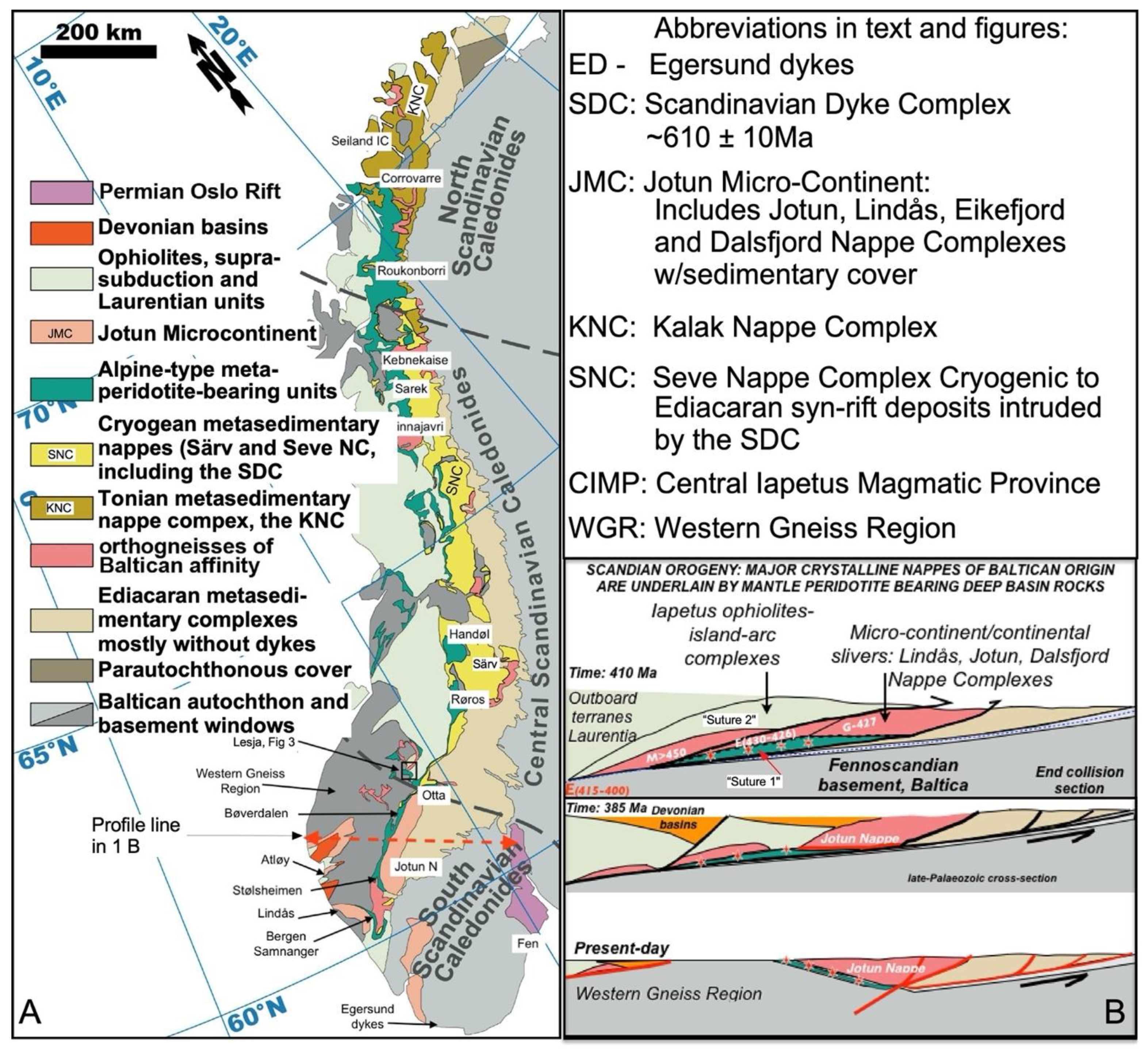
2. New Tectonic Models: From ‘Dismembered Ophiolites’ to Mantle Exhumation and Formation of Microcontinents by Rifting and Hyperextension
3. The Distal Margin of the Jotun Microcontinent (JMC) and the Magma-Poor to Magma-Rich Transition Zone
4. The Magma-Rich Segment of the Pre-Caledonian Baltican Margin: The Scandinavian Dyke Complex (SDC)
5. Discussion
6. Conclusions
Author Contributions
Funding
Acknowledgments
Conflicts of Interest
References
- Peron-Pinvidic, G.; Manatschal, G.; Alves, T.; Andersen, T.B.; Andres-Martiniz, M.; Autin, J.; Ball, P.; Brune, S.; Cadenas, P.; Cresswell, D.; et al. “IMAGinING RIFTING” Workshop Participants. Rifted Margins: State of the Art and Future Challenges. Front. Earth Sci. 2019, 7. [Google Scholar] [CrossRef]
- Nystuen, J.P.; Andresen, A.; Kumpulainen, R.A.; Siedlecka, A. Neoproterozoic Basin Evolution in Fennoscandia, East Greenland and Svalbard. Episodes 2008, 31, 35–43. [Google Scholar] [CrossRef] [PubMed]
- Jakob, J.; Andersen, T.B.; Kjøll, H.J. A Review and Reinterpretation of the Architecture of the South and South-Central Scandinavian Caledonides—A Magma-Poor to Magma-Rich Transition and the Significance of the Reactivation of Rift Inherited Structures. Earth-Sci. Rev. 2019, 192, 513–528. [Google Scholar] [CrossRef]
- Boillot, G.; Grimaud, S.; Mauffret, A.; Mougenot, D.; Kornprobst, J.; Mergoil-Daniel, J.; Torrent, G. Ocean-Continent Boundary off the Iberian margin: A Serpentinite Diapir West of the Galicia Bank. EPSL 1980, 48, 23–34. [Google Scholar] [CrossRef]
- Boillot, G.; Recq, M.; Winterer, E.L.; Meyer, A.W.; Applegate, J.; Baltuck, M.; Bergen, J.A.; Comas, M.C.; Davies, T.A.; Dunham, K.; et al. Tectonic Denudation of the Upper Mantle along Passive Margins: A Model Based on Drilling Results (ODP Leg 103, Western Galicia Margin, Spain). Tectonophysics 1987, 132, 335–342. [Google Scholar] [CrossRef]
- Boillot, G.; Froitzheim, N. Non-Volcanic Rifted Margins, Continental Break-up and the Onset of Sea-Floor Spreading: Some Outstanding Questions. Geol. Soc. Lond. Spec. Publ. 2001, 187, 9–30. Available online: https://sp.lyellcollection.org/content/187/1/9 (accessed on 28 November 2021). [CrossRef]
- Peron-Pinvidic, G.; Manatschal, G.; Osmundsen, P.T. Structural Comparison of Archetypal Atlantic Rifted Margins: A Review of Observations and Concepts. Mar. Pet. Geol. 2013, 43, 21–47. [Google Scholar] [CrossRef]
- Abdelmalak, M.M.; Andersen, T.B.; Planke, S.; Faleide, J.I.; Corfu, F.; Tegner, C.; Shephard, G.E.; Zastrozhnov, D.; Myklebust, R. The Ocean-Continent Transition in the Mid-Norwegian Margin: Insight from Seismic Data and an Onshore Caledonian Field Analogue. Geology 2015, 43, 1011–1014. [Google Scholar] [CrossRef]
- Osmundsen, P.T.; Peron-Pinvidic, G.; Ebbing, J.; Erratt, D.; Fjellanger, E.; Bergslien, D.; Syvertsen, S.E. Extension, Hyperextension and Mantle Exhumation Offshore Norway: A Discussion Based on 6 Crustal Transects. Nor. J. Geol. 2016, 96, 343–372. [Google Scholar] [CrossRef]
- Manatschal, G. New Models for Evolution of Magma-Poor Rifted Margins Based on a Review of Data and Concepts from West Iberia and the Alps. Int. J. Earth Sci. 2004, 93, 432–466. [Google Scholar] [CrossRef]
- Epin, M.E.; Manatschal, G.; Amann, M. Defining Diagnostic Criteria to Describe the Role of Rift Inheritance in Collisional Orogens: The Case of the Err-Platta Nappes. Swiss J. Geosci. 2017, 110, 1–20. [Google Scholar] [CrossRef]
- Lagabrielle, Y.; Labaume, P.; de Saint Blanquat, M. Mantle Exhumation, Crustal Denudation, and Gravity Tectonics during Cretaceous Rifting in the Pyrenean Realm (SW Europe): Insights from the Geological Setting of the Lherzolite Bodies. Tectonics 2010, 29, 1–26. [Google Scholar] [CrossRef]
- Clerc, C.; Lagabrielle, Y.; Neumaier, M.; Reynaud, J.Y.; de Saint Blanquat, M. Exhumation of Subcontinental Mantle Rocks: Evidence from Ultramafic-Bearing Clastic Deposits nearby the Lherz Peridotite Body, French Pyrenees. Bull. Soc. Géol. France 2012, 183, 443–459. [Google Scholar] [CrossRef]
- Beltrando, M.; Manatschal, G.; Mohn, G.; Dal Piaz, G.V.; Vitale Brovarone, A.; Masini, E. Recognizing Remnants of Magma-Poor Rifted Margins in High-Pressure Orogenic Belts: The Alpine Case Study. Earth-Sci. Rev. 2014, 131, 88–115. [Google Scholar] [CrossRef]
- Andersen, T.B.; Labrousse, L.; Corfu, F.; Osmundsen, P.T. Evidence for Hyperextension along the Pre-Caledonian Margin of Baltica. J. Geol. Soc. Lond. 2012, 169, 601–612. [Google Scholar] [CrossRef]
- van Staal, C.R.; Chew, D.M.; Zagorevski, A.; McNicoll, C.; Hibbard, J.; Sébastien, C.; Escayola, M.P.; Sylvester, P.J. Evidence of Late Ediacaran Hyperextension of the Laurentian Iapetan Margin in the Birchy Complex, Baie Verte Peninsula, North-West Newfoundland: Implications for the Opening of Iapetus, Formation of Peri-Laurentian Microcontinents and Taconic-Grampian Orogenesis. Geosci. Can. 2013, 40, 94–117. [Google Scholar] [CrossRef]
- Chew, D.M.; van Staal, C.R. The Ocean-Continent Transition Zones along the Appalachian–Caledonian Margin of Laurentia: Examples of Large-Scale Hyperextension during the Opening of the Iapetus Ocean. Geosci. Can. 2014, 41–42, 165–185. [Google Scholar] [CrossRef]
- Franke, D. (Rifting, Lithosphere Breakup and Volcanism: Comparison of Magma-Poor and Volcanic Rifted Margins. Mar. Pet. Geol. 2013, 43, 63–87. Available online: https://www.sciencedirect.com/science/article/abs/pii/S0264817212002322 (accessed on 28 November 2021). [CrossRef]
- Dewey, J.F.; Burke, K. Hot Spots and Continental Break-up: Implications for Collisional Orogeny. Geology 1974, 2, 57–60. [Google Scholar] [CrossRef]
- Gee, D.G.; Andréasson, P.-G.; Li, Y.; Krill, A. Baltoscandian Margin, Sveconorwegian Crust Lost by Subduction during Caledonian Collisional Orogeny. GFF 2016, 139, 36–51. [Google Scholar] [CrossRef]
- Talbot, C.J.; Ghebreab, W. Red Sea Detachment and Basement Core Complexes in Eritrea. Geology 1997, 25, 655–658. [Google Scholar] [CrossRef]
- Bastow, I.D.; Keir, D. The Protracted Development of the Continent–Ocean Transition in Afar. Nat. Geosci. 2011, 4, 248. [Google Scholar] [CrossRef]
- Klausen, M.B.; Larsen, H.C. East Greenland Coast-Parallel Dike Swarm and Its Role in Continental Breakup. Spec. Paper Geol. Soc. Am. 2002, 362, 133–158. [Google Scholar] [CrossRef]
- Geoffroy, L. Volcanic Passive Margins. Comptes Rendus Geosci. 2005, 337, 1395–1408. [Google Scholar] [CrossRef]
- Svenningsen, O.M. The Baltica–Lapetus Passive Margin Dyke Complex in the Sarektjokka Nappe, Northern Swedish Caledonides. Geol. J. 1994, 29, 323–354. [Google Scholar] [CrossRef]
- Andréasson, P.-G.; Allen, A.; Aurell, O.; Boman, D.; Ekestubbe, J.; Goerke, U.; Lundgren, A.; Nilsson, P.; Sandelin, S. Seve Terranes of the Kebnekaise Mts., Swedish Caledonides, and Their Amalgamation, Accretion and Affinity. GFF 2018, 140, 1–28. [Google Scholar] [CrossRef]
- Kjøll, H.J.; Andersen, T.B.; Corfu, F.; Labrousse, L.; Tegner, C.; Abdelmalak, M.M.; Planke, S. Timing of Break-up and Thermal Evolution of a Pre-Caledonian Neoproterozoic Exhumed Magma-Rich Rifted Margin. Tectonics 2019, 38, 1843–1862. [Google Scholar] [CrossRef]
- Kjøll, H.J.; Galland, O.; Labrousse, L.; Andersen, T.B. Emplacement Mechanisms of a Dyke Swarm across the Brittle-Ductile Transition and the Geodynamic Implications for Magma-Rich Margins. Earth Planet. Sci. Lett. 2019, 518, 223–235. [Google Scholar] [CrossRef]
- Tegner, C.; Andersen, T.B.; Kjøll, H.J.; Brown, E.L.; Hagen-Peter, G.; Corfu, F.; Planke, S.; Torsvik, T.H. A Mantle Plume Origin for the Scandinavian Dyke Complex: A Piercing Point for the 615 Ma Plate Reconstruction of Baltica. Geochem. Geophys. Geosyst. 2019, 20, 1075–1094. [Google Scholar] [CrossRef]
- White, R.S.; Smith, L.K.; Roberts, A.W.; Christie, P.A.F.; Kusznir, N.J. The iSIMM Team. Lower-Crustal Intrusion on the North Atlantic Continental Margin. Nature 2008, 452, 460–464. [Google Scholar] [CrossRef]
- French, S.W.; Romanowicz, B. Broad Plumes Rooted at the Base of the Earth’s Mantle beneath Major Hotspots. Nature 2015, 525, 95–99. Available online: https://www.nature.com/articles/nature14876 (accessed on 28 November 2021). [CrossRef] [PubMed]
- Dubrovine, P.V.; Steinberger, B.; Torsvik, T.H. A Failure to Reject: Testing the Correlation between Large Igneous Provinces and Deep Mantle Structures with EDF Statistics. Geochemistry 2016, 17, 1130–1163. [Google Scholar] [CrossRef]
- Molnar, P. Lower Mantle Dynamics Perceived with 50 Years of Hindsight from Plate Tectonics. Geochem. Geophys. Geosyst. 2019, 20, 5619–5649. [Google Scholar] [CrossRef]
- Torsvik, T.H.; Van der Voo, R.; Doubrovine, P.V.; Burke, K.; Steinberger, B.; Ashwal, L.D.; Trønnes, R.; Webb, S.J.; Bull, A.L. Deep Mantle Structure as Reference Frame for Movements in and on the Earth. Proc. Nat. Acad. Sci. USA 2014, 111–124, 8735–8740. Available online: https://www.pnas.org/content/111/24/8735 (accessed on 28 November 2021). [CrossRef] [PubMed]
- Domeier, M. A Plate Tectonic Scenario for the Iapetus and Rheic Oceans. Gondwana Res. 2016, 36, 275–295. [Google Scholar] [CrossRef]
- Ernst, R.E.; Bell, K. Large Igneous Provinces (LIPs) and Carbonatites. Min. Petrol. 2010, 98, 55–76. [Google Scholar] [CrossRef]
- Bingen, B.; Demaiffe, D.; Breemen, O.V. The 616 Ma Old Egersund Basaltic Dike Swarm, SW Norway, and Late Neoproterozoic Opening of the Iapetus Ocean. J. Geol. 1998, 106, 565–574. [Google Scholar] [CrossRef]
- Walderhaug, H.J.; Torsvik, T.H.; Halvorsen, E. The Egersund Dykes (SW Norway): A reliable Early Ediacaran (Vendian) Palaeomagnetic Pole from Baltica. Geophys. J. Intern. 2007, 168, 935–948. [Google Scholar] [CrossRef]
- Meert, J.G.; Torsvik, T.H.; Eide, E.A.; Dahlgren, S. Tectonic Significance of the Fen Province, S. Norway. Constraints from Geochronology and Palaeomagnetism. J. Geol. 1998, 106, 553–564. [Google Scholar] [CrossRef]
- Roberts, R.J.; Corfu, F.; Torsvik, T.H.; Ashwal, L.D.; Ramsay, D.M. Short-Lived Mafic Magmatism at 560–570 Ma in the Norwegian Caledonites: U-Pb Zircon Ages from the Seiland Igneous Province. Geol. Mag. 2006, 143, 887–903. [Google Scholar] [CrossRef]
- Roberts, R.J.; Corfu, F.; Torsvik, T.H.; Hetherington, C.J.; Ashwal, L.D. Age of Alkaline Rocks in the Seiland Igneous Province, Northern Norway. J. Geol. Soc. Lond. 2010, 167, 71–81. Available online: https://jgs-lyellcollection-org.ezproxy.uio.no/content/167/1/71 (accessed on 28 November 2021). [CrossRef]
- Larsen, R.B.; Grant, T.; Sørensen, B.E.; Tegner, C.; McEnroe, S.; Pastore, Z.; Fichler, C.; Nikolaisen, E.; Grannes, K.R.; Church, N.; et al. Portrait of a Giant Deep-Seated Magmatic Conduit System: The Seiland Igneous Province. Lithos 2018, 296–299, 600–622. [Google Scholar] [CrossRef]
- Andersen, T.B.; Jamtveit, B.; Dewey, J.F.; Swensson, E. Subduction and Eduction of Continental Crust; Major Mechanisms during Continent-Continent Collision and Orogenic Extensional Collapse. Terra Nova 1991, 3, 303–310. [Google Scholar] [CrossRef]
- Jakob, J.; Alsaif, M.; Corfu, F.; Andersen, T.B. Age and Origin of Thin Discontinuous Gneiss Sheets in the Distal Domain of the Magma-Poor Hyperextended Pre-Caledonian Margin of Baltica, Southern Norway. J. Geol. Soc. Lond. 2017, 174, 557–571. Available online: https://jgs-lyellcollection-org.ezproxy.uio.no/content/174/3/557 (accessed on 28 November 2021). [CrossRef]
- Furnes, H.; Ryan, P.D.; Grenne, T.; Roberts, D.; Sturt, B.A.; Prestvik, T. Geological Land Geochemical Classification of the Ophiolite Fragments in the Scandinavian Caledonides. In The Caledonide Orogen-Scandinavia and Related Areas; Gee, D.G., Sturt, B.A., Eds.; Wiley: New York, NY, USA, 1985; pp. 657–670. [Google Scholar]
- Andersen, T.B.; Andresen, A. Stratigraphy, Tectonostratigraphy and Accretion of Outboard Terranes in the Caledonides of Sunnhordland W. Norway. Tectonophys 1994, 231, 71–84. [Google Scholar] [CrossRef]
- Slagstad, T.; Pin, C.; Roberts, D.; Kirkland, C.L.; Grenne, T.; Dunning, G.; Sauer, S.; Andersen, T. Tectonomagmatic Evolution of the Early Ordovician Suprasubduction-Zone Ophiolites of the Trondheim Region, Mid-Norwegian Caledonides. Spec. Publ. Geol. Soc. Lond. 2014, 390, 541–561. Available online: https://sp-lyellcollection-org.ezproxy.uio.no/content/390/1/541 (accessed on 28 November 2021). [CrossRef]
- Bruton, D.L.; Harper, D.A.T. Brachiopods and Trilobites of the Early Ordovician Serpentine Otta Conglomerate, South Central Norway. Nor. J. Geol. 1981, 61, 153–181. Available online: http://www.geologi.no/images/NJG_articles/NGT_61_2_153-181.pdf (accessed on 28 November 2021).
- Torsvik, T.H.; Cocks, R. Earth History and Palaeogeography; University Press Cambridge: Cambridge, UK, 2017; p. 291. Available online: https://www.cambridge.org/core/books/abs/earth-history-and-palaeogeography/earth-history-and-palaeogeography/09D7FE97DD2EDBF59F857B8CC697C6E3 (accessed on 29 November 2021).
- Slagstad, T.; Kirkland, C.L. Timing of Collision Initiation and Location of the Scandian Orogenic Suture in the Scandinavian Caledonides. Terra Nova 2018, 30, 179–188. [Google Scholar] [CrossRef]
- Roberts, D.; Gee, D.G. An Introduction to the Structure of the Scandinavian Caledonides. In The Caledonide Orogen–Scandinavia and Related Areas; Gee, D.G., Sturt, B.A., Eds.; Wiley: New York, NY, USA, 1985; pp. 55–68. [Google Scholar]
- Stephens, M.B.; Gee, D.G. Terranes and Polyphase Accretionary History in the Scandinavian Caledonides. Geol. Soc. Am. Spec. Paper 1989, 230, 17–30. [Google Scholar] [CrossRef]
- Corfu, F.; Andersen, T.B.; Gasser, D. The Scandinavian Caledonides: Main Features, Conceptual Advances and Critical Questions. Spec. Publ. Geol. Soc. Lond. 2014, 390, 9–43. [Google Scholar] [CrossRef]
- Froitzheim, N.; Eberli, G.P. Extensional Detachment Faulting in the Evolution of a Tethys Passive Continental Margin, Eastern Alps, Switzerland. Geol. Soc. Am. Bull. 1990, 102, 1297–1308. [Google Scholar] [CrossRef]
- Faerseth, R.B.; Thon, A.; Larsen, S.G.; SIivertsen, A.; Elvestad, L. Geology of the Lower Palaeozoic Rocks in the Samnanger–Osterøy, Area, Major Bergen Arc, Western Norway. Bull. Nor. Geol. Unders. 1977, 334, 19–58. [Google Scholar]
- Roberts, D. The Scandinavian Caledonides: Event Chronology, Paleogeographic Settings and Likely, Modern Analogues. Tectonophys 2003, 365, 283–299. [Google Scholar] [CrossRef]
- Nilsson, L.-P.; Roberts, D. A Trail of Ophiolitic Debris and Its Detritus along the Trøndelag-Jämtland Border: Correlations and Palaeogeographical Implications. Bull. Nor. Geo. Unders. 2014, 453, 29–41. Available online: https://www.ngu.no/upload/Publikasjoner/Bulletin/Bulletin453_29-41.pdf (accessed on 28 November 2021).
- Andersen, T.B.; Berry, H.N.; Lux, D.R.; Andresen, A. The Tectonic Significance of Pre-Scandian 40Ar/39Ar Phengite Cooling Ages the Caledonides of Western Norway. J. Geol. Soc. Lond. 1998, 155, 297–309. Available online: https://jgs-lyellcollection-org.ezproxy.uio.no/content/155/2/297 (accessed on 28 November 2021). [CrossRef]
- Root, D.; Corfu, F. U–Pb Geochronology of Two Discrete Ordovician High-Pressure Metamorphic Events in the Seve Nappe Complex, Scandinavian Caledonides. Contrib. Min. Petrol. 2012, 163, 769–788. [Google Scholar] [CrossRef]
- Glodny, J.; Kühn, A.; Austrheim, H. Geochronology of Fluid-Induced Eclogite and Amphibolite Facies Metamorphic Reactions in a Subduction–Collision System, Bergen Arcs, Norway. Contrib. Min. Petrol. 2008, 156, 27–48. [Google Scholar] [CrossRef]
- Stigh, J. Ultramafites and Detrital Serpentinites in the Central and Southern Parts of the Caledonian Allochthon in Scandinavia. Ph.D. Thesis, University of Gothenburg, Gothenburg, Sweden, 1979; 222p. [Google Scholar]
- Qvale, H.; Stigh, J. Ultramafic Rocks in the Scandinavian Caledonides. In The Caledonide Orogen-Scandinavia and Related Areas; Gee, D.G., Sturt, B.A., Eds.; Wiley: New York, NY, USA, 1985; pp. 693–715. [Google Scholar]
- Enger, A.S. Solitary Mantle Peridotite Bodies in Stølsheimen, Central South Norway. Master’s Thesis, University of Oslo, Oslo, Norway, 2016; 147p. Available online: https://www.duo.uio.no/handle/10852/50179 (accessed on 28 November 2021).
- Jakob, J.; Boulvais, P.; Andersen, T.B. Oxygen and Carbon Isotope Composition from a Regional Melange Basin in the South Norwegian Caledonides: Origin and Resetting. Intern. J. Earth Sci. 1917, 107, 1445–1463. [Google Scholar] [CrossRef]
- Dunkel, K.G.; Jamtveit, B.; Austrheim, H. Ophicarbonates of the Feragen Ultramafic Body, Central Norway. Nor. J. Geol. 2019, 99, 3. [Google Scholar] [CrossRef]
- Dilek, Y.; Furnes, H. Ophiolites and Their Origins. Elements 2014, 10, 93–100. Available online: https://pubs.geoscienceworld.org/msa/elements/article-abstract/10/2/93/137595/Ophiolites-and-Their-Origins (accessed on 28 November 2021). [CrossRef]
- Harper, D.A.T.; Bruton, D.L.; Rasmussen, C.M.Ø. The Otta Brachiopod and Trilobite Fauna: Palaeogeography of Early Palaeozoic Terranes and Biotas across Baltoscandia. Foss. Strata 2008, 54, 31–40. [Google Scholar]
- Bonatti, E.; Hamlyn, P.R.; Ottonello, G. Upper Mantle beneath a Young Oceanic Rift: Peridotites from the Island of Zabargad (Red Sea). Geology 1981, 9, 474–479. Available online: https://pubs.geoscienceworld.org/gsa/geology/article/9/10/474/195751/Upper-mantle-beneath-a-young-oceanic-rift (accessed on 28 November 2021). [CrossRef]
- Beinlich, A.; Austrheim, H.; Glodny, J.; Erambert, M.; Andersen, T.B. CO2 Sequestration and Extreme Mg Depletion in Serpentinised Peridotite Clasts from the Devonian Solund Basin, SW-Norway. Geochim. Cosmochim. Acta 2010, 74, 6935–6964. [Google Scholar] [CrossRef]
- Bergman, S. A Possible Ophiolite at Handöl, Swedish Caledonides. GFF 1987, 109, 340–343. [Google Scholar] [CrossRef]
- Bergman, S. P-T Paths in the Handöl Area, Central Scandinavia: Record of Caledonian Accretion of Outboard Rocks to the Baltoscandian Margin. J. Metam. Geol. 1992, 10, 265–281. [Google Scholar] [CrossRef]
- Beinlich, A.; Plümper, O.; Hövelmann, J.; Austrheim, H.; Jamtveit, B. Massive Serpentinite Carbonation at Linnajavri, N–Norway. Terra Nova 2012, 24, 446–455. [Google Scholar] [CrossRef]
- Beinlich, A.; Austrheim, H.; Mavromatis, V.; Grguric, B.; Putnis, C.V.; Putnis, A. Peridotite Weathering Is the Missing Ingredient of Earth’s Continental Crust Composition. Nat. Comm. 2018, 9, 1–12. [Google Scholar] [CrossRef]
- Fauconnier, J.; Labrousse, L.; Andersen, T.B.; Beyssac, O.; Duprat-Oualid, S.; Yamato, P. Thermal Structure of a Major Crustal Shear Zone, the Basal Thrust in the Scandinavian Caledonides. Earth Planet. Sci. Lett. 2014, 385, 162–171. [Google Scholar] [CrossRef]
- Kjelberg, Ø. Petrography, Structure and Metamorphism of Mélange Rocks below the Jotun Nappe in Stølsheimen, Central South Norway. Master’s Thesis, University of Oslo, Oslo, Norway, 2015; 114p. Available online: https://www.duo.uio.no/handle/10852/49682 (accessed on 28 November 2021).
- Quintela, O. Structural Geology and Tectonic History of a Caledonian Metaperidotite-Bearing Metasedimentary Complex near Lesja, South Central Norway. Master’s Thesis, University of Oslo, Oslo, Norway, 2019; 141p. Available online: https://www.duo.uio.no/handle/10852/70023 (accessed on 28 November 2021).
- Bakke, S.; Korneliussen, A. Jack-Straw-Textured Olivines in some Norwegian Metaperidotites. Nor. J. Geol. 1986, 66, 271–276. Available online: http://www.geologi.no/images/NJG_articles/NGT_66_4_271-276.pdf (accessed on 28 November 2021).
- Hacker, B.R.; Andersen, T.B.; Johnston, S.; Kylander-Clark, A.R.; Peterman, E.M.; Walsh, E.O.; Young, D. High-Temperature Deformation during Continental-Margin Subduction & Exhumation: The Ultrahigh-Pressure Western Gneiss Region of Norway. Tectonophysics 2010, 480, 149–171. [Google Scholar] [CrossRef]
- Corfu, F.; Heim, M. Geochronology of Caledonian Metamorphic Allochthons in the Otta–Heidal Region, South Norway; Tectonostratigraphic and Palaeogeographic Implications. J. Geol. Soc. Lond. 2019, 177, 66–81. Available online: https://jgs-lyellcollection-org.ezproxy.uio.no/content/177/1/66 (accessed on 28 November 2021). [CrossRef]
- Corfu, F.; Andersen, T.B. Proterozoic Magmatisms in the Southern Scandinavian Caledonides with Special Reference to the Occurrences in the Eikefjord Nappe. GFF 2016, 138, 102–114. [Google Scholar] [CrossRef]
- Austrheim, H. Eclogitization of Lower Crustal Granulites by Fluid Migration through Shear Zones. EPSL 1987, 81, 221–232. [Google Scholar] [CrossRef]
- Brekke, H.; Solberg, P.O. The Geology of Atløy, Sunnfjord Western Norway. Bull. Nor. Geol. Unders. 1987, 410, 73–94. [Google Scholar]
- Jamtveit, B.; Moulas, E.; Andersen, T.B.; Austrheim, H.; Corfu, F.; Petley-Ragan, A.; Schmalholz, S. High-Pressure Metamorphism Caused by Fluid Induced Weakening of Deep Continental Crust. Sci. Rep. 2018, 8, 1–8. [Google Scholar] [CrossRef]
- Andréasson, P.-G.; Albrecht, L.G. Derivation of 500 Ma Eclogites from the Passive Margin of Baltica and a Note on the Tectonometamorphic Heterogeneity of Eclogite-Bearing Crust. Geol. Mag. 1995, 132, 729–773. [Google Scholar] [CrossRef]
- Brueckner, H.K.; van Roermund, H.L.M. Dunk Tectonics: A Multiple Subduction/Eduction Model for the Evolution of the Scandinavian Caledonides. Tectonics 2004, 23. [Google Scholar] [CrossRef]
- Klonowska, I.; Janak, M.; Majka, J.; Froitzheim, N.; Kosminska, K. Eclogite and Garnet Pyroxenite from Sor Jougdan, Seve Nappe Complex, Sweden: Implications for UHP Metamorphism of Allochthons in the Scandinavian Caledonides. J. Metam. Geol. 2016, 34, 103–119. [Google Scholar] [CrossRef]
- Corfu, F.; Andersen, T.B. U–Pb Ages of the Dalsfjord Complex, SW Norway, and Their Bearing on the Correlation of Allochthonous Crystalline Segments of the Scandinavian Caledonides. Int. J. Earth Sci. 2002, 91, 955–963. [Google Scholar] [CrossRef]
- Johnston, S.; Hacker, B.R.; Andersen, T.B. Exhuming Norwegian Ultrahigh-Pressure Rocks: Overprinting Extensional Structures and the Role of the Nordfjord-Sogn Detachment Zone. Tectonics 2007, 26, TC5001. [Google Scholar] [CrossRef]
- Andersen, T.B.; Skjerlie, K.P.; Furnes, H. The Sunnfjord Melange, Evidence of Silurian Ophiolite Accretion in the West Norwegian Caledonides. J. Geol. Soc. Lond. 1990, 147, 59–68. Available online: https://jgs-lyellcollection-org.ezproxy.uio.no/content/147/1/59 (accessed on 28 November 2021). [CrossRef]
- Eide, E.A.; Torsvik, T.H.; Andersen, T.B.; Arnaud, N.O. Early Carboniferous Unroofing in Western Norway: The Tale of Alkali Feldspar Thermochronology. J. Geol. 1999, 107, 353–374. [Google Scholar] [CrossRef]
- Furnes, H.; Skjerlie, K.P.; Pedersen, R.B.; Andersen, T.B.; Stillman, C.J. The Solund-Stavfjord Ophiolite Complex and Associated Rocks, West Norwegian Caledonides: Geology, Geochemistry and Tectonic Environment. Geol. Mag. 1990, 127, 209–224. [Google Scholar] [CrossRef]
- Jakob, J.; Andersen, T.B.; Mohn, G.; Kjøll, H.J.; Beyssac, O. A Revised Tectono-Stratigraphic Scheme for the Scandinavian Caledonides and Its Implications for Our Understanding of the Scandian Orogeny. Geol. Soc. Am. Spec. Paper. In New Developments in the Appalachian-Caledonian-Variscan Orogen; Kuiper, Y., Murphy, B., Nance, D., Strachan, R., Thompson, M., Eds.; Geological Society of America: Boulder, CO, USA; Available online: https://pubs.geoscienceworld.org/gsa/books/book/2335/New-Developments-in-the-Appalachian-Caledonian (accessed on 28 November 2021).
- Lindahl, I.; Nilsson, L.P. Geology of the Soapstone Deposits of the Linnajavri Area, Hamarøy, Nordland, North Norwegian Caledonides—Norway’s Largest Reserves of Soapstone. In Geological Survey of Norway Special Publication; Slagstad, T., Ed.; Geological Survey of Norway: Trondheim, Norway, 2008; Volume 11, pp. 19–35. Available online: https://www.ngu.no/upload/Publikasjoner/Special%20publication/SP11_LO.pdf (accessed on 28 November 2021).
- Kolstrup, M.L.; Maupin, V. A Proterozoic Boundary in Southern Norway Revealed by Joint-Inversion of P-Receiver Functions and Surface Waves. Precamb. Res. 2013, 238, 186–198. [Google Scholar] [CrossRef][Green Version]
- Gilotti, J.A.; Kumpulainen, R. Strain Softening Induced Ductile Flow in the Särv Thrust Sheet, Scandinavian Caledonides. J. Struct. Geo. 1986, 8, 441–455. [Google Scholar] [CrossRef]
- Andréasson, P.-G.; Svenningsen, O.; Johansson, I.; Solyom, Z.; Xiaodan, T. Mafic Dyke Swarms of the Baltica-Iapetus Transition, Seve Nappe Complex of the Sarek Mts., Swedish Caledonides. GFF 1992, 114, 31–45. [Google Scholar] [CrossRef]
- Svenningsen, O.M. Tectonic Significance of the Meta-Evaporitic Magnesite and Scapolite Deposits in the Seve Nappes, Sarek Mts., Swedish Caledonides. Tectonophys 1994, 231, 33–44. [Google Scholar] [CrossRef]
- Svenningsen, O.M. Onset of Seafloor Spreading in the Iapetus Ocean at 608 Ma Precise Age of the Sarek Dyke Swarm, Northern Swedish Caledonides. Precambrian Res. 2001, 110, 241–254. [Google Scholar] [CrossRef]
- Gasser, D.; Jeřábek, P.; Farber, C.; Stünitz, H.; Menegon, L.; Corfu, F.; Erembert, M.; Whitehouse, M.J. Behaviour of Geochronometers and Timing of Metamorphic Reactions during Deformation at Lower Crustal Conditions: Phase Equilibrium Modelling and U–Pb Dating. J. Metamorph. 2015, 33, 513–534. [Google Scholar] [CrossRef]
- Kjøll, H.-J. Neoproterozoic to Lower Paleozoic Evolution of the Pre-Caledonian Magma-Rich Margin of Baltica. Ph.D. Thesis, University of Oslo, Oslo, Norway, 2019; 242p. Available online: https://www.duo.uio.no/handle/10852/70340 (accessed on 28 November 2021).
- Kjøll, H.J. Late Neoproterozoic Basin Evolution of the Magma Rich Iapetus Margin of Baltica. Nor. J. Geol. 2020, 100, 32. [Google Scholar] [CrossRef]
- Rehnström, E.F.; Corfu, F. Paleoproterozoic U-Pb Ages of Allochthonous and Autochthonous Granites from the Northern Swedish Caledonides—Regional and Palaeogeographical Implications. Precamb. Res. 2004, 132, 363–378. [Google Scholar] [CrossRef]
- Rehnström, E.F.; Corfu, F.; Torsvik, T.H. Evidence of a Late Precambrian (637 Ma) Deformational Event in the Caledonides of Northern Sweden. J. Geol. 2002, 110, 591–601. [Google Scholar]
- Kirkland, C.L.; Bingen, B.; Whitehouse, M.J.; Beyerd, E.; Griffin, W.L. Neoproterozoic Palaeogeography in the North Atlantic Region: Inferences from the Akkajaure and Seve Nappes of the Scandinavian Caledonides. Precamb. Res. 2011, 186, 127–146. [Google Scholar] [CrossRef]
- Kirkland, C.L.; Daly, J.S.; Whitehouse, M.J. Tectonic Evolution of the Arctic Norwegian Caledonides from a Texturally- and Structurally-Constrained Multi-Isotopic (Ar-Ar, Rb-Sr, Sm-Nd, U-Pb) Study. Am. J. Sci. 2007, 307, 459–526. [Google Scholar] [CrossRef]
- Kirkland, C.L.; Daly, J.S.; Chew, D.M.; Page, L. The Finnmarkian Orogeny Revisited: An Isotopic Investigation of the Eastern Kalak Nappe Complex, Arctic Norway. Tectonophys 2008, 460, 158–177. [Google Scholar] [CrossRef]
- Corfu, F.; Roberts, R.J.; Torsvik, T.H.; Ashwal, L.D.; Ramsay, D.M. Peri-Gondwanan Elements in the Caledonian Nappes of Finnmark, Northern Norway: Implications for the Paleogeographic Framework of the Scandinavian Caledonides. Am. J. Sci. 2007, 307, 434–458. [Google Scholar] [CrossRef]
- Paulsson, O.; Andréasson, P.-G. Attempted Break-up of Rodinia at 850 Ma: Geochronological Evidence from the Seve−Kalak Superterrane, Scandinavian Caledonides. J. Geol. Soc. Lond. 2002, 159, 751–761. Available online: https://jgs.lyellcollection.org/content/159/6/751 (accessed on 28 November 2021). [CrossRef]
- Maijer, C.; Verschure, R.H. Petrology and Isotope Geology of the Hunnedalen Monzonoritic Dyke Swarm, SW Norway: A Possible Late Expression of Egersund Anorthosite Magmatism. Nor. Geol. Unders. Bull. 1998, 434, 83–107. Available online: https://openarchive.ngu.no/ngu-xmlui/handle/11250/2674084 (accessed on 28 November 2021).
- Kullerud, K.; Stephens, M.; Zachrisson, E. Pillow Lavas as Protoliths for Eclogites: Evidence from a Late Precambrian-Cambrian Continental Margin, Seve Nappes, Scandinavian Caledonides. Contrib. Min. Pet. 1990, 105, 1–10. [Google Scholar] [CrossRef]
- Stølen, L.K. The Rift-Related Mafic Dyke Complex of the Rouhkunborri Nappe, Indre Troms, Northern Norwegian Caledonides. GFF 1994, 116, 121–131. [Google Scholar] [CrossRef]
- Krabbendam, M.; Wain, A.; Andersen, T.B. Pre-Caledonian Granulite and Gabbro Enclaves in the Western Gneiss Region, Norway: Indications of Incomplete Transition at High Pressure. Geol. Mag. 2000, 137, 235–255. [Google Scholar] [CrossRef]
- Vrijmoed, J.C.; Podladchikov, Y.Y.; Andersen, T.B.; Hartz, E.H. An Alternative Model for Ultra-High Pressure in the Svartberget Fe-Ti Garnet-Peridotite, Western Gneiss Region, Norway. Eur. J. Min. 2009, 21, 1119–1133. [Google Scholar] [CrossRef]
- Majka, J.; Be’eri-Shlevin, Y.; Gee, D.G.; Ladenberger, A.; Claesson, S.; Konečný, P.; Klonowska, I. Multiple Monazite Growth in the Åreskutan Migmatite: Evidence for a Polymetamorphic Late Ordovician to Late Silurian Evolution in the Seve Nappe Complex of West-Central Jämtland, Sweden. J. Geosci. 2012, 57, 3–23. [Google Scholar] [CrossRef]
- Li, B.; Massonne, H.-J.; Zhang, J. Evolution of a Gneiss in the Seve Nappe Complex of Central Sweden—Hints at an Early Caledonian, Medium-Pressure Metamorphism. Lithos 2020, 376, 105746. [Google Scholar] [CrossRef]
- Baird, G.B.; Figg, S.A.; Chamberlain, K.R. Intrusive Age and Geochemistry of the Kebne Dyke Complex in the Seve Nappe complex, Kebnekaise Massif, Arctic SWEDEN Caledonides. GFF 2014, 136, 556–570. [Google Scholar] [CrossRef]
- van Roermund, H.; Majka, J.; Janák, M.; Klonowska, I. Orogenic (Spinel and Garnet) Peridotites and High and Ultrahigh Pressure Rocks of the Seve Nappe Complex, N. Jämtland, S. Västerbotten, Central Swedish Caledonides. In Proceedings of the 12th International Eclogite Conference, Pre-Conference Excursion Guide, Åre, Sweden, 20–29 August 2017. [Google Scholar]
- Dalquist, P. Late Ordovician (Hirnantian) Depositional Pattern and Sea-Level Change in Shallow Marine to Shoreface Cycles in Central Sweden. Geol. Mag. 2004, 141, 605–616. [Google Scholar] [CrossRef]
- Brueckner, H.K. Sinking Intrusion Model for the Emplacement of Garnet-Bearing Peridotites into Continent Collision Orogens. Geology 1998, 26, 631–634. [Google Scholar] [CrossRef]
- Scambelluri, M.; Pettke, T.; van Roermund, H.L.M. Majoritic Garnets Monitor Deep Subduction Fluid Flow and Mantle Dynamics. Geology 2008, 36, 59–62. [Google Scholar] [CrossRef]
- Slama, J.; Pedersen, R.B. Zircon Provenance of SW Caledonian Phyllites Reveals a Distant Timanian Sediment Source. J. Geol. Soc. Lond. 2015, 172, 465–478. Available online: https://jgs-lyellcollection-org.ezproxy.uio.no/content/172/4/465 (accessed on 28 November 2021). [CrossRef]
- Kühn, A.; Glodny, J.; Austrheim, H.; Råheim, A. The Caledonian Tectono-Metamorphic Evolution of the Lindås Nappe: Constraints from U-Pb, Sm-Nd and Rb-Sr Ages of Granitoid Dykes. Nor. J. Geol. 2000, 82, 45–57. [Google Scholar]
- Lundmark, A.M.; Corfu, F. Age and Origin of the Årdal Dike Complex, SW Norway: False Isochrons, Incomplete Mixing, and the Origin of Caledonian Granites in Basement Nappes. Tectonics 2007, 26, TC2007. [Google Scholar] [CrossRef]
- Andréasson, P.-G. The Continent-Ocean (Seve-Köli) Boundary in the Sarek-Padjelanta Mts. Revisited: Swedish Caledonides. GFF 2020, 142, 125–138. [Google Scholar] [CrossRef]
- Pedersen, R.B. Dunning, GR. Provenance of Turbiditic Cover to the Caledonian Solund-Stavfjord Ophiolite from U-Pb Single Zircon Dating. J. Geol. Soc. Lond. 1993, 150, 673–676. [Google Scholar] [CrossRef]
- Corfu, F.; Torsvik, T.H.; Andersen, T.B.; Ashwal, L.; Ramsay, D.M.; Roberts, R.J. Early Silurian Mafic-Ultramafic and Granitic Plutonism in Contemporaneous Flysch, Magerøy, Northern Norway: U-Pb Ages and Regional Significance. J. Geol., Soc. Lond. 2006, 163, 291–301. Available online: https://jgs-lyellcollection-org.ezproxy.uio.no/content/163/2/291 (accessed on 28 November 2021). [CrossRef]
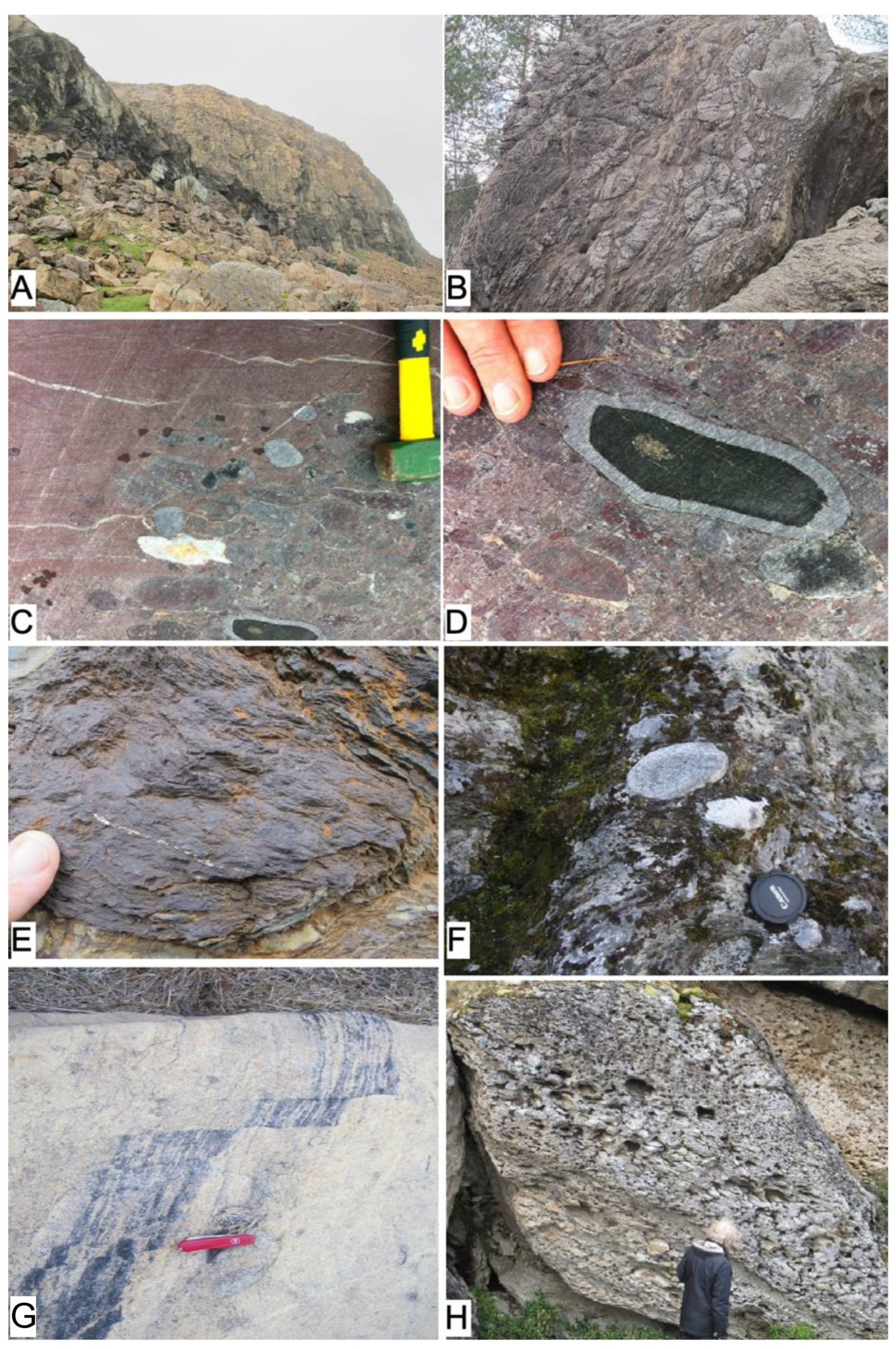
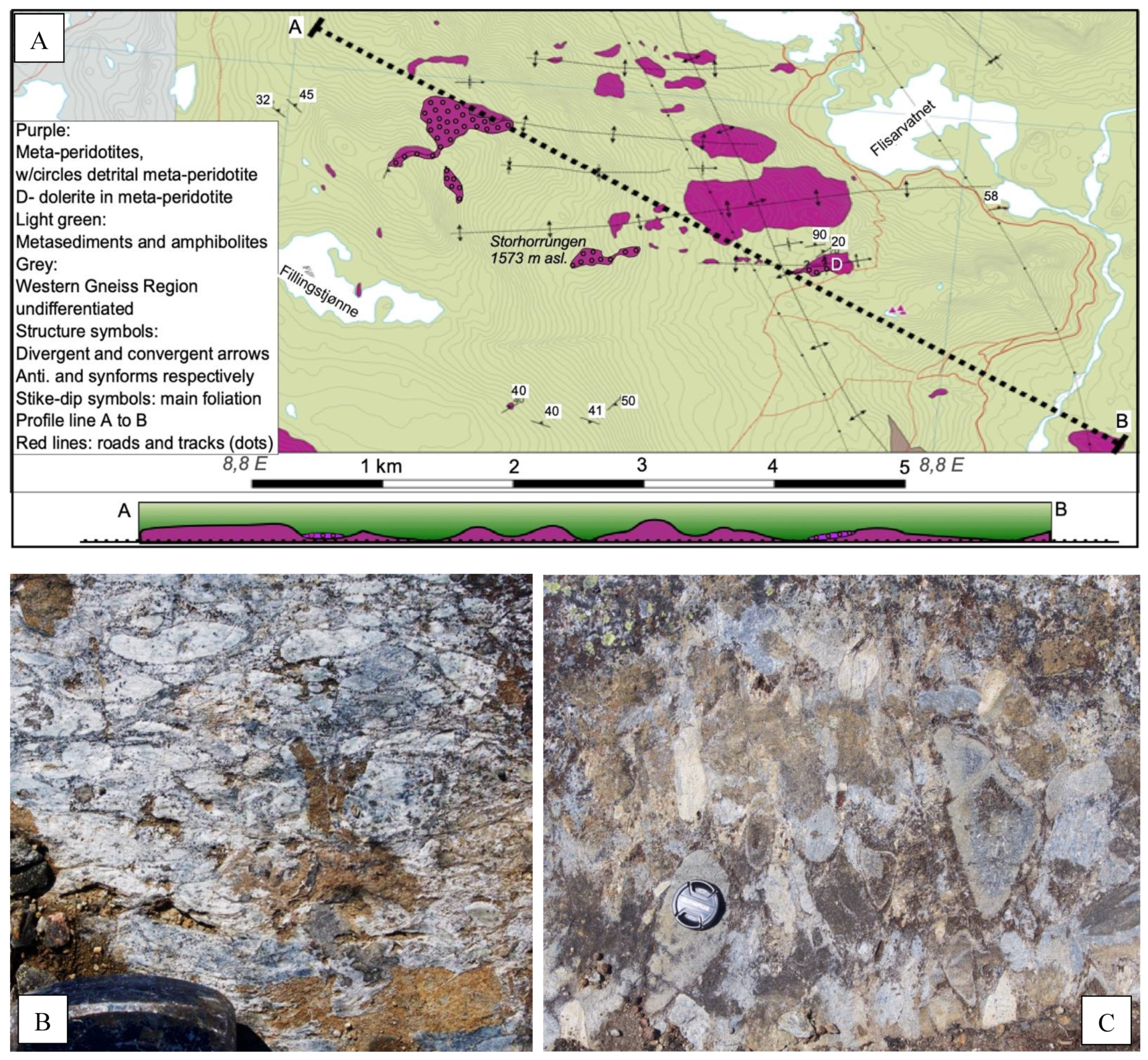
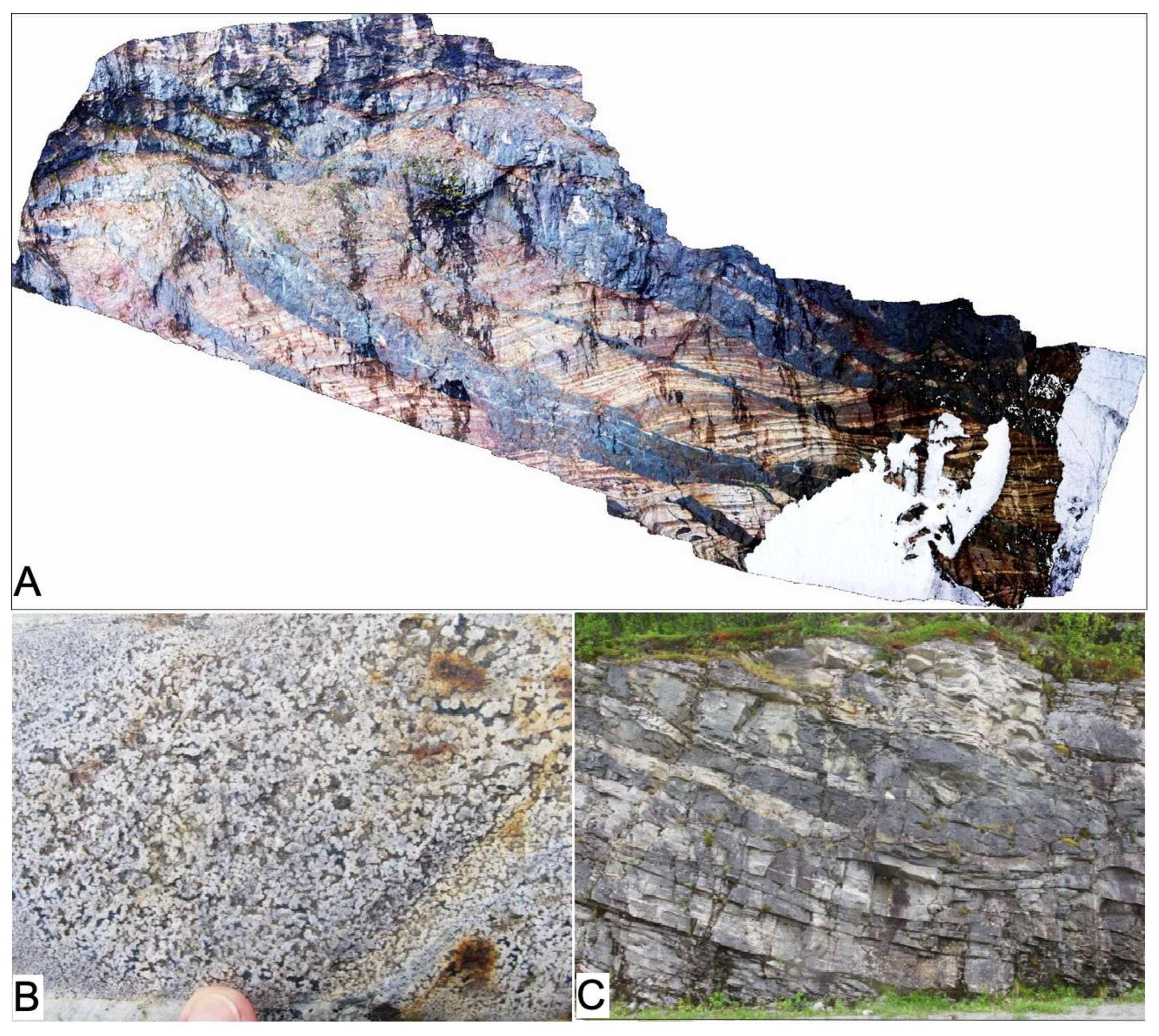
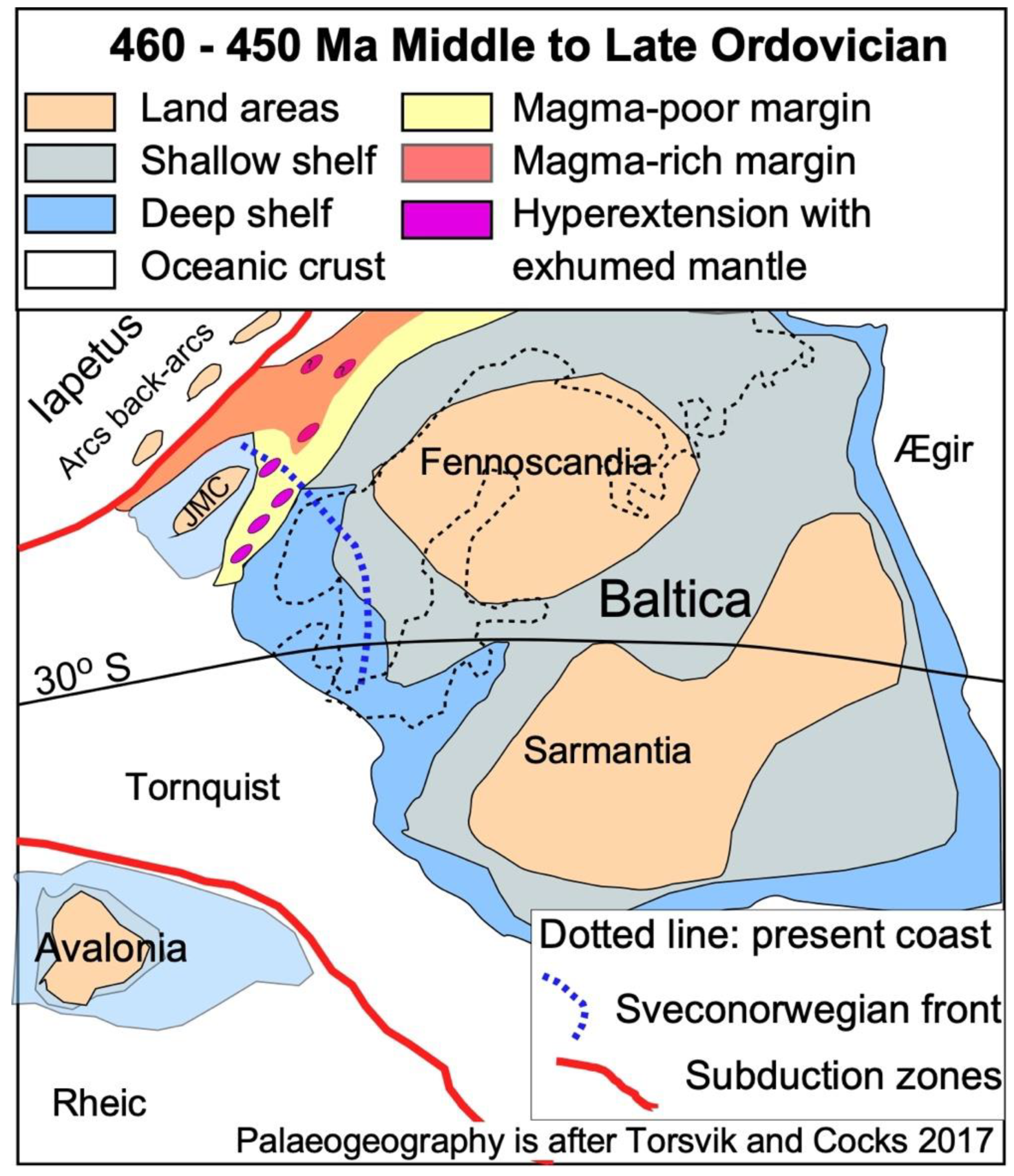
Publisher’s Note: MDPI stays neutral with regard to jurisdictional claims in published maps and institutional affiliations. |
© 2022 by the authors. Licensee MDPI, Basel, Switzerland. This article is an open access article distributed under the terms and conditions of the Creative Commons Attribution (CC BY) license (https://creativecommons.org/licenses/by/4.0/).
Share and Cite
Andersen, T.B.; Jakob, J.; Kjøll, H.J.; Tegner, C. Vestiges of the Pre-Caledonian Passive Margin of Baltica in the Scandinavian Caledonides: Overview, Revisions and Control on the Structure of the Mountain Belt. Geosciences 2022, 12, 57. https://doi.org/10.3390/geosciences12020057
Andersen TB, Jakob J, Kjøll HJ, Tegner C. Vestiges of the Pre-Caledonian Passive Margin of Baltica in the Scandinavian Caledonides: Overview, Revisions and Control on the Structure of the Mountain Belt. Geosciences. 2022; 12(2):57. https://doi.org/10.3390/geosciences12020057
Chicago/Turabian StyleAndersen, Torgeir B., Johannes Jakob, Hans Jørgen Kjøll, and Christian Tegner. 2022. "Vestiges of the Pre-Caledonian Passive Margin of Baltica in the Scandinavian Caledonides: Overview, Revisions and Control on the Structure of the Mountain Belt" Geosciences 12, no. 2: 57. https://doi.org/10.3390/geosciences12020057
APA StyleAndersen, T. B., Jakob, J., Kjøll, H. J., & Tegner, C. (2022). Vestiges of the Pre-Caledonian Passive Margin of Baltica in the Scandinavian Caledonides: Overview, Revisions and Control on the Structure of the Mountain Belt. Geosciences, 12(2), 57. https://doi.org/10.3390/geosciences12020057





